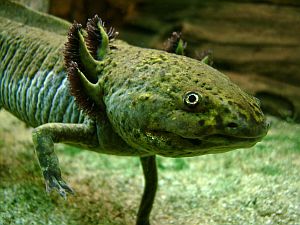Mexico City, Mexico - Earlier this year, the Mexican salamander-like creature the axolotl (pronounced ACK-suh-LAH-tuhl) was thought to be extinct in its natural habitat, as efforts by researchers in skiffs trying to net the amphibian in the shallow, muddy waters of Xochimilco lake found none.
But, biologist Armando Tovar Garza of Mexico's National Autonomous University said this week that members of his team are carrying out a second search, and have spotted two of the slippery little creatures in Mexico City's lakes.
"We weren't able to catch them ... because the behavior of the axolotl makes them very difficult to capture," said Garza. "But we do have two sightings. That's important, because it tells us we still have a chance."
Colloquially known as the "water monster" and the "Mexican walking fish," the axolotl resides in the Xochimilco network of lakes and canals in Mexico - the "floating gardens" of earth piled on reed mats that the Aztecs built to grow crops, but are now suffering from pollution, urban sprawl, and invasive species. A close relative of the tiger salamander, roasted axolotl is considered to be a delicacy in Mexico.
 |
In a statement, the Mexican Academy of Sciences revealed that there were 6,000 axolotls per square kilometer in 1998, 1,000 per square kilometer in 2003, and a mere 100 per square kilometer in 2008. Alarmed by the creature's falling numbers, researchers have taken steps to protect the dwindling axolotl population by creating "shelters" in Xochimilco over the past few years - selected areas where rocks and reedy plants are placed to serve as filters, while cleaner water is pumped creating better living situations.
But the surrounding garden-islands have increasingly been converted to illicit shantytowns, with untreated sewage often running off into the water.
The goal of the shelters is to create a sanctuary for the axolotl where they don't have to compete for food with the Asian carp and African tilapia, two breeds of non-native fish that were introduced to the lake's ecosystem years ago and have the same dietary preferences as the axolotls.
Axolotls are notorious for being "ugly" creatures, boasting odd-looking gills, a slimy tail, a wide head, lidless eyes, and an overall strange appearance. The "water monster" can grow up to a foot long and have four feet which are used to walk at the bottom of lakes or to swim like alligators. The carnivorous amphibian feasts mainly on aquatic insects, small fish, and crustaceans.
Axolotls have the ability to regenerate lost body parts, and as such they are one of the most scientifically studied salamanders in the world. Millions of axolotls are said to have once lived in the lakes of Xochimilco and Chalco and according to legend, Xolotl - the Aztec dog-headed god of death, fire, sickness, and deformities - changed into an axolotl and fled into the lake fearing death.
Original Story


